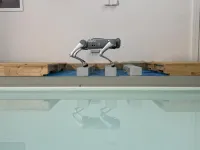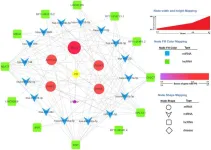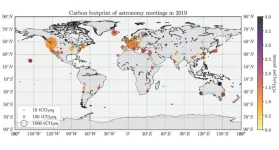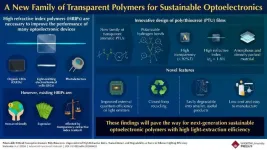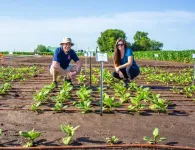(Press-News.org) With the help of a form of machine learning called deep reinforcement learning (DRL), the EPFL robot notably learned to transition from trotting to pronking – a leaping, arch-backed gait used by animals like springbok and gazelles – to navigate a challenging terrain with gaps ranging from 14-30cm. The study, led by the BioRobotics Laboratory in EPFL’s School of Engineering, offers new insights into why and how such gait transitions occur in animals.
“Previous research has introduced energy efficiency and musculoskeletal injury avoidance as the two main explanations for gait transitions. More recently, biologists have argued that stability on flat terrain could be more important. But animal and robotic experiments have shown that these hypotheses are not always valid, especially on uneven ground,” says PhD student Milad Shafiee, first author on a paper published in Nature Communications.
Shafiee and co-authors Guillaume Bellegarda and BioRobotics Lab head Auke Ijspeert were therefore interested in a new hypothesis for why gait transitions occur: viability, or fall avoidance. To test this hypothesis, they used DRL to train a quadruped robot to cross various terrains. On flat terrain, they found that different gaits showed different levels of robustness against random pushes, and that the robot switched from a walk to a trot to maintain viability, just as quadruped animals do when they accelerate. And when confronted with successive gaps in the experimental surface, the robot spontaneously switched from trotting to pronking to avoid falls. Moreover, viability was the only factor that was improved by such gait transitions.
“We showed that on flat terrain and challenging discrete terrain, viability leads to the emergence of gait transitions, but that energy efficiency is not necessarily improved,” Shafiee explains. “It seems that energy efficiency, which was previously thought to be a driver of such transitions, may be more of a consequence. When an animal is navigating challenging terrain, it’s likely that its first priority is not falling, followed by energy efficiency.”
A bio-inspired learning architecture
To model locomotion control in their robot, the researchers considered the three interacting elements that drive animal movement: the brain, the spinal cord, and sensory feedback from the body. They used DRL to train a neural network to imitate the spinal cord’s transmission of brain signals to the body as the robot crossed an experimental terrain. Then, the team assigned different weights to three possible learning goals: energy efficiency, force reduction, and viability. A series of computer simulations revealed that of these three goals, viability was the only one that prompted the robot to automatically – without instruction from the scientists – change its gait.
The team emphasizes that these observations represent the first learning-based locomotion framework in which gait transitions emerge spontaneously during the learning process, as well as the most dynamic crossing of such large consecutive gaps for a quadrupedal robot.
“Our bio-inspired learning architecture demonstrated state-of-the-art quadruped robot agility on the challenging terrain,” Shafiee says.
The researchers aim to expand on their work with additional experiments that place different types of robots in a wider variety of challenging environments. In addition to further elucidating animal locomotion, they hope that ultimately, their work will enable the more widespread use of robots for biological research, reducing reliance on animal models and the associated ethics concerns.
END
Trotting robots reveal emergence of animal gait transitions
A four-legged robot trained with machine learning by EPFL researchers has learned to avoid falls by spontaneously switching between walking, trotting, and pronking – a milestone for roboticists as well as biologists interested in animal locomotion.
2024-04-30
ELSE PRESS RELEASES FROM THIS DATE:
Lundquist investigator Dr. Ashraf Ibrahim is the lead author in the landmark study on pioneering oral fungal infection treatment showing promise in preclinical trials
2024-04-30
A novel oral amphotericin B (MAT2203) developed by Matinas BioPharma for treatment of invasive mucormycosis (IM) and other deadly invasive fungal infections, has demonstrated encouraging results in a series of preclinical studies. The groundbreaking research, led by Lundquist Institute (TLI) Investigator Ashraf Ibrahim, PhD, has been published in the journal Antimicrobial Agents and Chemotherapy.
The studies focused on MAT2203, an oral lipid nanocrystal formulation of amphotericin B, which has previously demonstrated safety and effectiveness in the clinical treatment of various fungal infections. The research aimed ...
Deep-learning decoding for a noninvasive brain-computer interface
2024-04-30
Brain-computer interfaces (BCIs) have the potential to make life easier for people with motor or speech disorders, allowing them to manipulate prosthetic limbs and employ computers, among other uses. In addition, healthy and impaired people alike could enjoy BCI-based gaming. Non-invasive BCIs that work by analyzing brain waves recorded through electroencephalography are currently limited by inconsistent performance. Bin He and colleagues used deep-learning decoders to improve a BCI’s performance responding to ...
Elucidating the role of a shared lncRNA-miRNA-mRNA network in exacerbating Parkinson’s disease symptoms in the context of COVID-19 infection
2024-04-30
Background and objectives
Parkinson’s disease (PD) is a common neurodegenerative disorder with unclear molecular mechanisms. Noncoding RNAs, such as microRNAs (miRNAs) and long noncoding RNAs (lncRNAs), have been identified as critical regulators of gene expression. This study aimed to investigate the triple network of lncRNA-miRNA-mRNA, known as competing endogenous RNAs (ceRNAs), and to identify essential lncRNAs that regulate PD-related gene expression through their target miRNAs. The study also identified a common triple network between COVID-19 and PD that may contribute to exacerbating PD symptoms.
Methods
A bioinformatics approach was employed to construct ...
American College of Lifestyle Medicine announces unique screening tool for clinicians to efficiently assess patient dietary patterns
2024-04-30
The American College of Lifestyle Medicine (ACLM) has developed a clinical tool to help health care professionals incorporate a food as medicine approach into their practice by assessing and tracking the proportion of whole, unrefined plant-based foods and water intake in their patients’ dietary patterns.
The ACLM Diet Screener, a 27-item diet assessment tool available free on ACLM’s website, was designed to guide clinical conversations around diet and support nutrition prescriptions, while also being brief enough for use during routine ...
Cranberry extracts could boost microbiota and counter cardiometabolic diseases
2024-04-30
Québec, April 30, 2024 - Cranberry extracts appear to improve intestinal microbiota and help prevent chronic diseases such as diabetes and cardiovascular diseases. The study of Université Laval and the Institute of Nutrition and Functional Foods (INAF) reported beneficial effects after only four days of use.
Cranberries and berries are associated with multiple health benefits, mainly attributed to their high content of polyphenols, in the form of tannins. They also contain high concentrations of oligosaccharides, small fibres that are thought to contribute to their bioactivity.
The research team, led by Yves Desjardins, professor ...
Discovery of uranium-contaminated soil purification material without secondary environmental pollution
2024-04-30
Nuclear energy has long been regarded as a next-generation energy source, and major countries around the world are competing to secure cutting-edge technologies by leveraging the high economic efficiency and sustainability of nuclear power. However, uranium, which is essential for nuclear power generation, has serious implications for both soil ecosystems and human health. Despite being a key radioactive material, uranium poses significant health risks due to its chemical toxicity to the kidneys, bones, and cells. As a result, both the U.S. Environmental Protection Agency and the World Health Organization recommend allowing and advocating for uranium concentrations in wastewater ...
The carbon emissions of academic astronomy
2024-04-30
The carbon emissions associated with air travel to professional conferences make up a sizable fraction of the emissions produced by academia. Andrea Gokus and colleagues estimated the CO2-equivalent emissions for conference travel to all 362 open meetings in the field of astronomy in 2019. The total is an estimated 42,500 tCO2e, or about one ton per participant per meeting. According to the authors, networking and discussing new scientific developments at meetings is important for advancing the field, but adjustments can be made to reduce the hefty carbon cost. Holding meetings virtually ...
Journal of Pharmaceutical Analysis articles reveal the importance of phytocompounds and metabolomics analysis
2024-04-30
IBD is a common chronic gastrointestinal disorder and current treatment strategies can cause adverse effects. Thus, there is a need to identify alternative compounds to treat IBD. Similarly, the dose-related toxicity and efficacy of anticancer drugs needs to be monitored accurately to improve the treatment outcomes. Moreover, over the years, plant-based therapeutic compounds and traditional Chinese medicine formulas have gained attention for their enhanced healing effects and are promising for various treatment regimens.
The recent issue of the JPA, published ...
Great strides in the development of high refractive index polymers for optoelectronics
2024-04-30
Optoelectronic devices have found their way into many aspects of our daily lives, from OLED displays to photodetectors, security systems, and environmental monitoring. In all the applications, these devices utilize high refractive index polymers (HRIPs) to control light.
In general, the optical properties of transparent HRIPs enable efficient light transmission and manipulation, allowing optoelectronics devices to guide and control the flow of light to improve their performance. However, there are no low-cost options for HRIPs that can guarantee good optical performance while being transparent and environmentally ...
Engineered increase in mesophyll conductance improves photosynthetic efficiency in field trial
2024-04-30
It is possible to engineer increased mesophyll conductance in plants according to new research from the University of Illinois. Mesophyll conductance plays a key role in photosynthesis and refers to the ease with which CO2 can diffuse through a leaf’s cells before reaching the location where it is ultimately turned into sugar to feed the plant (carbon fixation). CO2 faces barriers as it moves through the leaf, including its own cell walls. Researchers from the Long Lab found that by increasing permeability and slightly reducing the thickness of cell walls, they could increase CO2 diffusion and uptake in a model crop.
“This is one of the ...
LAST 30 PRESS RELEASES:
Researchers identify gene that calms the mind and improves attention in mice
Artificial metabolism turns waste CO2 into useful chemicals
Ancient sea anemone sheds light on animal cell type evolution
Begging gene leads to drone food
How climate policies that incentivize and penalize can drive the clean energy transition
Can community awareness campaigns in low-resource areas improve early diagnosis of colorectal cancer?
Stardust study resets how life’s atoms spread through space
Practical education: Clinical scenario-based program development
The impact of family dynamics on eating behaviour – how going home for Christmas can change how you eat
Tracing the quick synthesis of an industrially important catalyst
New software sheds light on cancer’s hidden genetic networks
UT Health San Antonio awarded $3 million in CPRIT grants to bolster cancer research and prevention efforts in South Texas
Third symposium spotlights global challenge of new contaminants in China’s fight against pollution
From straw to soil harmony: International team reveals how biochar supercharges carbon-smart farming
Myeloma: How AI is redrawing the map of cancer care
Manhattan E. Charurat, Ph.D., MHS invested as the Homer and Martha Gudelsky Distinguished Professor in Medicine at the University of Maryland School of Medicine
Insilico Medicine’s Pharma.AI Q4 Winter Launch Recap: Revolutionizing drug discovery with cutting-edge AI innovations, accelerating the path to pharmaceutical superintelligence
Nanoplastics have diet-dependent impacts on digestive system health
Brain neuron death occurs throughout life and increases with age, a natural human protein drug may halt neuron death in Alzheimer’s disease
SPIE and CLP announce the recipients of the 2025 Advanced Photonics Young Innovator Award
Lessons from the Caldor Fire’s Christmas Valley ‘Miracle’
Ant societies rose by trading individual protection for collective power
Research reveals how ancient viral DNA shapes early embryonic development
A molecular gatekeeper that controls protein synthesis
New ‘cloaking device’ concept to shield sensitive tech from magnetic fields
Researchers show impact of mountain building and climate change on alpine biodiversity
Study models the transition from Neanderthals to modern humans in Europe
University of Phoenix College of Doctoral Studies releases white paper on AI-driven skilling to reduce burnout and restore worker autonomy
AIs fail at the game of visual “telephone”
The levers for a sustainable food system
[Press-News.org] Trotting robots reveal emergence of animal gait transitionsA four-legged robot trained with machine learning by EPFL researchers has learned to avoid falls by spontaneously switching between walking, trotting, and pronking – a milestone for roboticists as well as biologists interested in animal locomotion.
